Advantages and disadvantages of water heaters
With the fact that there are storage and flow water heaters, with their principle of operation, we figured out
Now we will pay attention separately to the pros and cons of each version of the system, so that you can determine for yourself which one is better to choose a water heater
Additionally, water heaters are classified according to the method of installation - floor and wall models:
- Most often, preference is given to wall models if you need to choose an electric water heater for an apartment.
- Floor standing - more bulky, but also more powerful. They are often chosen to serve a spacious private house with several bathrooms.
Cumulative
You think an electric storage water heater is the best. On the whole, you are right.
This statement is due to the following advantages:
- You can choose any volume based on whether you want to install an electric storage water heater in your country house or apartment. Manufacturers offer models from 10 liters to 10 thousand liters inclusive. So some of them are applicable even for operation in manufacturing plants and offices.
- The ability to connect to a regular 220V outlet.
- The heated water remains hot for about 2-4 hours without additional power consumption.
- Can be used to service multiple water intake points.
- The water pressure in the system does not affect the pressure in any way, only the remainder of the available hot water in the tank.
- A wide range of shapes, sizes, shades - design and dimensions are easy to choose for the conditions of any room.
- Scale in such systems accumulates to a lesser extent than in instantaneous water heaters.
Disadvantages that must be considered when buying:
- Even the most compact models take up useful space, which is not always beneficial, for example, for small apartments, where literally every centimeter counts.
- If you choose a large electric storage water heater, you will have to wait a long time for heating.
- Expect your electricity bills to go up right away, especially if you turn on your equipment frequently and during the day, rather than using the more favorable night rates.
- If you do not control the flow, you can find yourself in a situation when, while taking a shower, the water in the tank runs out, and you will have to continue to be content with exceptionally cold water in order to complete all your hygiene procedures.

Flowing
The performance of an instantaneous water heater can be much higher than a storage water heater, if the characteristics of the system are correctly selected for specific operating conditions.
Pros:
- Compact dimensions. Requires no additional usable space for installation.
- There are no restrictions on the volume of water, as the heating takes place in “real time”.
Minuses:
- High energy consumption.
- The complexity of installation work, since it is necessary to lay a separate cable from the shield.
- Suitable for servicing only 1 water intake point.
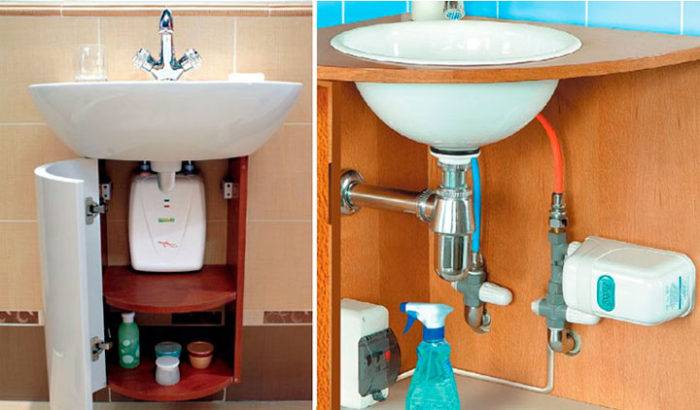
Flow-through storage models
These are advanced devices that can operate in 2 modes - an instantaneous and storage water heater.
Pros:
- Compact dimensions.
- Functionality.
- Possibility of uninterrupted supply of hot water with the choice of a more economical mode.
Minuses:
- The storage tanks are usually small.
- The connection includes the same nuances as the installation of an instantaneous water heater.

Tips & Tricks
So, in order not to regret your choice of a boiler for an apartment, before buying, you need to take into account all the nuances that may arise when using it, as well as the technical characteristics of the device. This is, first of all, on what scale, industrial or individual, the device will be used, how large its power consumption and performance.
Choice based on energy source
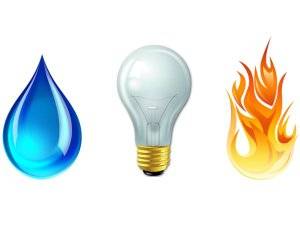 Depending on the source of energy from which the heaters operate, they can be electric or gas. Which boiler to choose for an apartment - this decision is only yours.
Depending on the source of energy from which the heaters operate, they can be electric or gas. Which boiler to choose for an apartment - this decision is only yours.
Here you need to proceed from the availability of gas or electricity supply at home, as well as from saving money, which one way or another will have to be spent on paying for electricity or gas supply services when using a boiler.
Most people prefer to use electric boilers at home because they generally do not require any additional power line connection costs to get them connected. Such a heater can be operated from a conventional power supply.
Many people use gas water heaters to heat water in the house, which are not inferior in their technical characteristics to electric ones. The use of such water heaters allows you to save money on utility bills.
Other nuances
In order for the boiler to serve you for a long time, when choosing it, you need to focus on the manufacturer, as well as on the following factors:
- reliability;
- quality;
- durability of use;
- affordable cost.
At the same time, pay attention to the terms of the warranty service of the water heater, because even the most reliable equipment can have malfunctions.
To find out more information on how to choose the right boiler for an apartment, watch this video:
With the advice in this article in mind, we hope you don't make the mistake of choosing a useful appliance in your home like a boiler. Have a good choice!
Have a good choice!
Water heater selection parameters
Having figured out which type of equipment is better to buy, it's time to start reviewing the parameters that need to be considered when choosing a heater.
Volume
When choosing a cumulative version of the model, first calculate the standard volume of water consumption for your family. Usually, the consumption of one person at a time is as follows:
- 5-18 liters - when using the washbasin;
- 40-90 l - shower cabin;
- 25-35 l - kitchen sink.
Based on the number of people in the family, the optimal tank volumes will be as follows:
- 15-35 l - for one person;
- 50-80 l - 2;
- 80-120 liters - for 2-3 family members;
- from 100 liters if the family has more than 4 people.
Tank material
When choosing a storage water heater, attention should be paid to the material of the tank. The options can be as follows:
- Stainless steel is a durable, undemanding, durable material that does not lend itself much to corrosion. The average warranty for such models is about 8 years.
- Carbon steel coated with titanium oxide - perfectly withstands any temperature extremes, has good strength and anti-corrosion characteristics. The warranty usually covers equipment with a service life of up to 6 years.
- Enamelled steel. The cheapest option with a warranty period of no more than 3 years. Although it all depends on the manufacturer and the materials he uses. More suitable as an economy option for a summer residence with not very frequent visits.
Heating element type
The heater is one of the most important elements of the entire system, because it is he who is responsible for the timely heating of the water. Therefore, you need to understand its structure:
- Open, otherwise they are called "wet". They are directly in a liquid medium, therefore they provide a high heating rate. Such models are inexpensive.
- Closed, otherwise "dry". Here the heating element is located in a special flask, that is, it does not come into contact with the liquid medium. Pros - less risk of corrosion, short circuit, longer service life. Cons - such a water heater will cost a lot, and the water may not heat up as quickly as we would like if there is only 1 heating element.
Dimensions (edit)
The dimensions of the equipment are important when choosing an installation location. A variety of options are on sale - classic shapes and dimensions, narrow, ultra-thin models. Therefore, there are usually no problems with choosing a heater.
What can be considered:
- On average, the diameter of the container is 45-50 cm.
- The height depends on the volume of the storage tank, in the range of 50-160 cm.
Power
The power of the water heater can also vary greatly, so when choosing, consider:
- The optimal values are 2-3 kW.
- Models from 3 to 6 kW will heat water much faster, but the electricity consumption will also be higher. Plus, not all wiring is capable of withstanding such stress, especially in old multi-storey buildings.
- Low-power units from 0.75 to 1 kW can cause inconvenience, since you will have to wait a very long time for the next portion of water to heat up.
Heating rate
The factor of your personal convenience depends on the speed of heating the water in the storage tank.
Therefore, pay attention to this parameter. The norm is considered:
- heating the volume of about 30-50 liters in 40-60 minutes;
- heating the volume over 200 liters in 5-7 hours.
Control method
There are 2 options here:
- Mechanics, such a device has rotary knobs and controls. The disadvantages of such a system are the low accuracy of temperature setting, the advantages are the lower price and high reliability.
- Electronics - there is a display with a touch panel. Pros - functionality, the ability to fine-tune the heating mode, temperature, improved protection. Cons - the higher price of the water heater, the risk of breakdown, in which repairs will be impractical or impossible.
Instantaneous water heaters
A flow-through boiler is a device that almost instantly heats water to the desired temperature, and at the same time, its installation does not require a search for a place, since it does not have a storage tank for water.
This type of water heater is advantageous in that it can supply an almost unlimited amount of hot water.
The principle of operation of such devices is that while a thin layer of water washes the heating element, it has time to heat up quite strongly. It should be borne in mind that the stronger the water pressure, the lower the temperature of its outlet flow. Therefore, do not expect a powerful flow of very hot water.
When choosing, you need to take into account that one of its main advantages is compactness, that is, it does not require much space to install it.
However, before buying, you should make sure that the electrical wiring in the house is reliable, since the device has a sufficiently large power consumption.
Gas storage water heaters
It is more expedient to install storage-type equipment where there is no centralized hot water supply.
Flowing
Installation of devices of this type refers to the most effective and simple way to provide the consumer with hot water. Their power varies from 2 to 15 kW.
Instantaneous water heater for tap
Pressure models can be installed in a riser, which allows you to provide heated water to all points of water intake in the house. Non-pressure devices, which are among the simplest and most popular, are mounted directly on the crane and are put into operation after opening it.
Flow devices consume more energy, moreover, they are dependent on its availability at the moment of switching on. However, they are compact, easy to manage and cost less than their storage counterparts. Some energy savings are provided by the lack of energy consumption at rest.
Water heater flowing tap with LCD display and temperature sensors
Today, hybrid equipment is also produced - flow-through storage water heaters. These units are capable of quickly heating water (which characterizes flow-through varieties) and storing it in a tank. However, devices of this type are not so often found on the market due to low consumer interest.This is due to their high cost and design complexity.
When choosing a water heater in an apartment, as a rule, flow-through models are installed
Which water heater to choose for your home?
Unlike apartments, where there is little space, in a private house it is quite spacious, so it is better to choose a storage heater in the house than a flow heater. Thanks to the large volume of the tank, it will be able to store enough warm water. Plus, if the water is turned off, you will always have a supply.
For those who do not experience problems with turning off the water or who live in a cramped apartment, it is recommended to take the flow-through version.
Here is a rating with an overview of the characteristics of some models, so that it is easier for you to understand the difference and decide which water heater is better.
Timberk WHEL-7 OC
An excellent option for a good instantaneous water heater for a private house with an affordable price and decent characteristics:
- Power - 6.5 kW, can be adjusted in 3 modes.
- Productivity - 4.5 l / min.
- Connection - 220 V mains, bottom connection.
- Protection class - IPX4.
- The body is made of thermoplastic.

Timberk WHEL-7 OC
ELECTROLUX EWH 80
Specifications:
- Volume - 80 liters.
- Power - 2 kW, there is a setting of several modes.
- Heating element - closed, 2 pieces.
- Management - mechanics.
- Tank material - enamel.
- There is a built-in magnesium anode.
- Thermal insulation - polyurethane foam.
- Protection class - IPX4.
- Water heating rate - 3 hours.
- Dimensions - 72.9 x 45.4 x 46.9 cm.
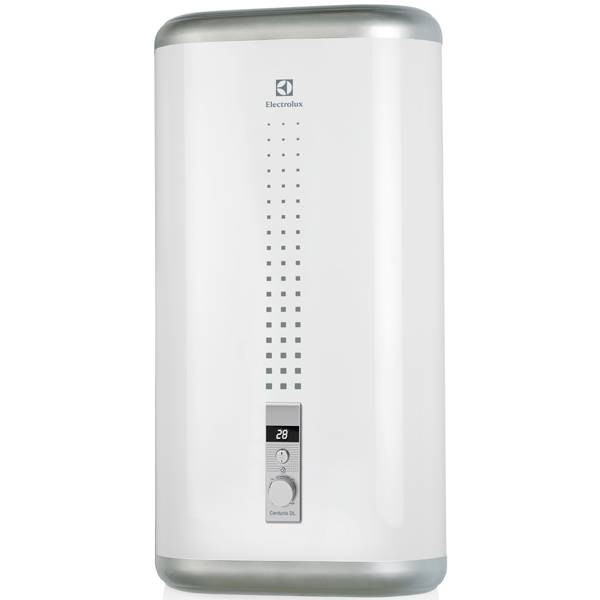
Model ELECTROLUX EWH 80
BOSCH Tronic 1000 TR1000T 50 SB (slim)
This is a variant of the compact storage model from the German manufacturer. At the same time, the price of the device is quite pleasing.
Specifications:
- Power - 1.5 kW.
- Volume - 50 liters.
- Management - mechanics.
- Tank coating - glass ceramics.
- TEN - open type.
- Dimensions - 80x39x40 cm.

Model BOSCH Tronic 1000 TR1000T 50 SB
Aeg EWH 120 Universal EL
This model belongs to the elite class of vehicles. Manufacturer - Germany, assembly can be performed in Slovenia. This brand is considered one of the best manufacturers of various household appliances for the home.
Specifications:
- Power - 3 kW.
- Volume - 120 liters.
- Management is electronic.
- There is a magnesium anode.
- Number of heating elements - 2, closed type.
- Tank material - enamelled steel.
- Dimensions - 47.5x120x47.5 cm.
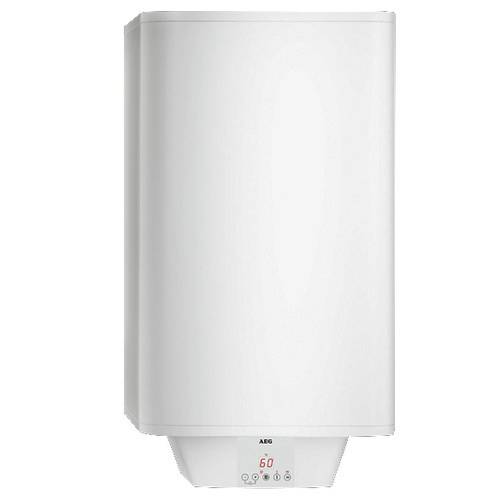
Model Aeg EWH 120 Universal EL
Which electric water heater is better to buy in a private house

Above, we described the types of electrical devices for heating water. They all have their own characteristics. Something is more suitable for an apartment, something for a manor house. How to choose a water heater for a private house?
Experts agree that in this case it is better to use accumulative models. Such water heaters make it possible to fully provide a family with hot water.
This is important, since there is no centralized supply of this resource in houses.
If you want to install a water heater in a summer cottage, which you do not visit for more than a few hours a day, then a low-power flow-through device is quite suitable. It will be able to heat water for washing hands and dishes, which will be quite enough in the country. True, in this case, you have to make sure that the wiring of the village house will withstand such a load.
It is especially important to check it if the housing was built a very long time ago and not by you
In the absence of running water, there is no choice. We have to be content with self-loading models.
If you are thinking which water heater is better to buy for a private house, consider also the reviews of people already using devices of different types. They should be looked for on the forums, as well as on the websites of water heater manufacturers. There you can find practical advice on choosing, as well as on repairing technical devices for water heating.
The principle of operation of an instantaneous and storage water heater
These types of equipment, regardless of the source of heating, have fundamental design differences. This is what makes it possible to determine the best option for a heater to provide autonomous hot water supply to a house or apartment.
How flow heaters work
This equipment is available in electrical and gas versions. The power of electrical equipment can be up to 36 kW. This is a very high figure, which provides for connection to a 380V network. It is far from always there, and laying such a line is accompanied by high costs and the need to collect a lot of information, which is not suitable for everyone. Manufacturers offer an extensive range of devices for a standard 220V network. Since it is often a powerful consumer, it is necessary for him to lay a power cable from the electrical panel.
 Diagram of an electric instantaneous water heater
Diagram of an electric instantaneous water heater
The principle of operation of such a device, regardless of whether it works on gas or electricity, is the same. When the water is opened on the mixer, the automatic system is triggered, as a result of which the stream passing through the body of the device begins to warm up intensively. It takes 3-5 seconds for the hot jet to come out. Even if you return from vacation, when all the equipment in the house was de-energized, and you turn on the water heater, you will immediately be able to use warm water.
The automatic mechanism that provides the inclusion of heating can be electric or hydraulic. The most durable is hydraulic. The device reacts to pressure changes in the pipeline. That is, if you open the mixer, the pressure drops, which signals the need for intensive heating. If the electronics break down, repairs will be more expensive.
 Scheme of operation of a gas flow column
Scheme of operation of a gas flow column
How storage heaters work
The storage electric water heater has a fundamental difference, since its design provides for a container in which the heating heating element is located. Such a device turns on, heats up the liquid to the set temperature, and then constantly maintains it. When you open the mixer, water flows out of the storage tank, while a portion of cold takes its place. The new stream mixes with the existing hot accumulations. At the same time, when the temperature drops, the heating element turns on and quickly heats the water to the desired level. This design is very similar to a large kettle.
 The scheme of operation of a gas electric boiler
The scheme of operation of a gas electric boiler
A storage gas boiler has a lot in common with a pot and stove. Its hermetic container is connected to the water supply. Cold water flows into it. Below is a burner, which, under the control of automation, periodically lights up and maintains the temperature of the liquid. When you open the hot tap on the mixer, a free space will appear in the tank. To fill it, a cold stream will enter, which will cause the thermostat probe to cool. As a result, the boiler will light up again and restore the required temperature value.
 Gas boiler diagram
Gas boiler diagram
We choose a water heater in accordance with the amount of hot water consumed
Considering the water consumption, it is possible to purchase a tank of small, medium and large sizes. Diesel boilers are not yet so popular in our country, but in Western countries such a water supply and heating system for country houses is the most common.
Such water heaters are very comfortable in that their workflow does not require loading of fuel. A plus is also a possible switch to gas consumption. Connecting a water heater is easy. But the installation of the system will require a lot of labor and cash injections. Nevertheless, for a very short period of use of the equipment, all the laboriousness of the work pays off.
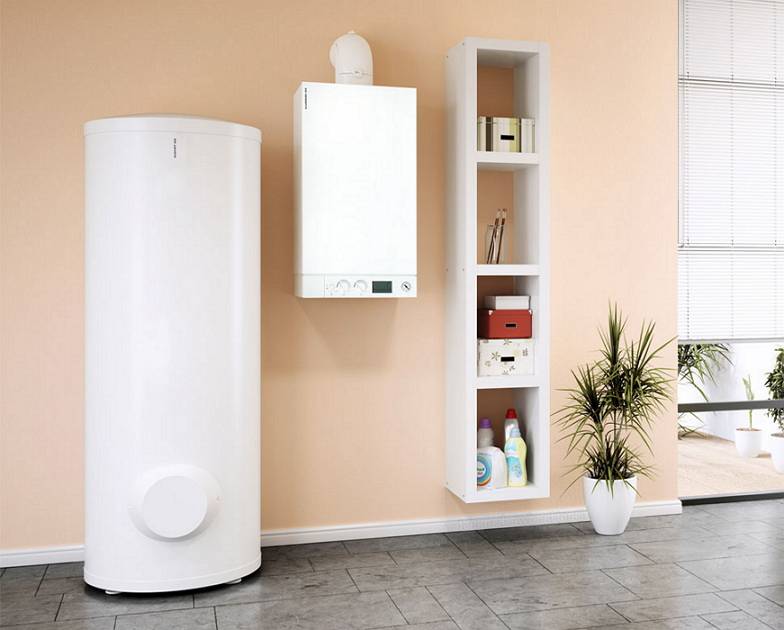
Types of water heaters by type of energy carrier
An important parameter for choosing a water heater is the type of energy that will be used to heat the water. For installation in apartments and houses, 2 variants of water heaters are usually chosen:
- electrical;
- gas.
These energy sources are the most common. Gas is not supplied to every house, but electricity is available even in remote dachas.If it is possible to put both options, then it is necessary to disassemble the pros and cons of each type of equipment.
Electric water heater
This equipment works according to the general principle with a kettle or boiler. The device is equipped with a metal heating element in the form of a tube, inside which there is an incandescent spiral. It gets very hot, and since the heating element is surrounded by water, its temperature rises at the same time. Installation of such equipment does not require the involvement of specialized installers. If the house or apartment has a power outlet that can withstand the required voltage, then the heater can be installed on its own in one working day. Problems with bringing a cold water pipe to it can be solved by using a flexible hose, refusing the help of a plumber.
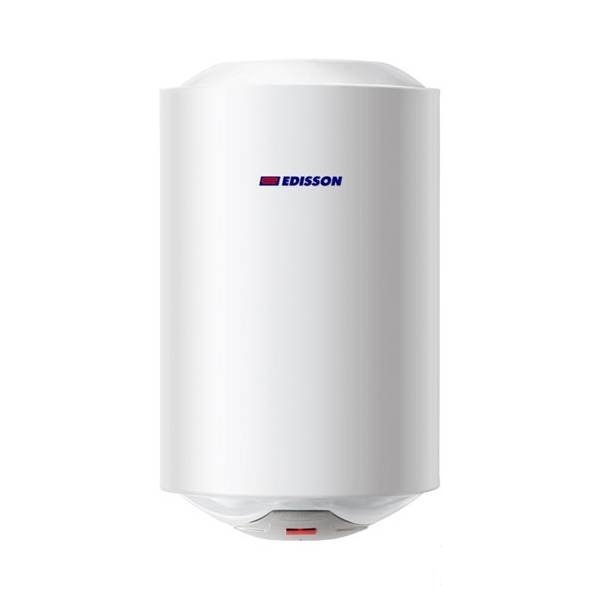 Electric heater
Electric heater
In general, the benefits of electric water heaters include:
- ease of installation;
- no need for the construction of a chimney;
- high security;
- low noise level;
- the ability to install anywhere;
- closing with furniture facades is allowed.
As for the disadvantages, it is one and significant - the high cost of electricity. In terms of heating 1 liter of liquid, electricity is used for a greater amount than for burning gas.
Gas water heater
This equipment is the most profitable financially. However, this advantage comes with a number of disadvantages:
- the need to attract professional installers;
- the construction of a chimney will be required;
- before installation, you need to improve the ventilation system.
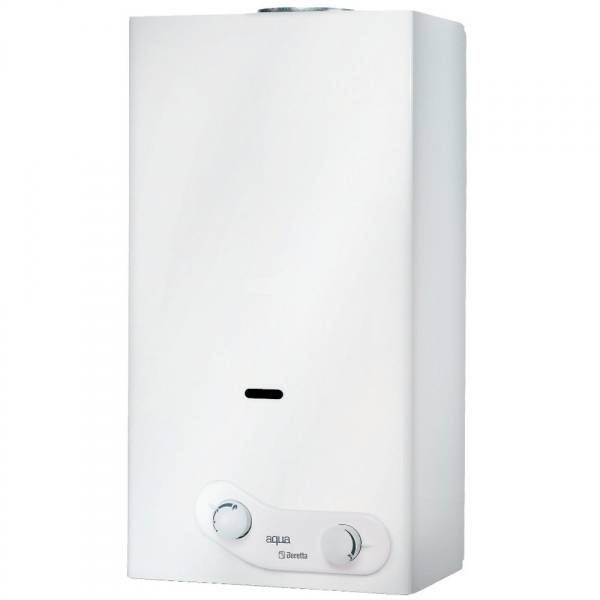 Gas water heater
Gas water heater
Gas equipment is much louder than electrical equipment. During its operation, it will be necessary to periodically carry out maintenance, in particular, cleaning the chimney. Since oxygen is burned from the room to provide heating, the air in the apartment and house quickly becomes stale. In the absence of proper ventilation, you will need to periodically open windows. Often in an apartment, a gas water heater is installed in the kitchen, since only there are the necessary communications for its connection. The operating rules prohibit hiding it in lockers, therefore the idyll of the interior is violated. When installing a gas heater, you need to be prepared for periodic checks by the regulatory authorities.
Types of boilers
There are three main types of electric water heaters (boilers): storage, instantaneous and combined. They differ from each other not only in size and appearance, but also in cost. Let's consider each of these types separately.
Boilers are of different types
Cumulative
They are also called high-capacity water heaters. Such devices are capable of holding large amounts of hot water, heating it from time to time to the temperature set by the user. The storage tank is great for large families where a lot of warm water is required every day.
Storage boiler
Flowing
Unlike storage boilers, flow-through boilers heat water immediately before being fed to the tap. Therefore, hot water is provided in unlimited quantities. The flow-through devices are compact, so they do not take up much space in the bathroom. Of course, there are also downsides. For example, when opening several taps in an apartment at once, the water will not have time to heat up to the desired temperature.
Instantaneous boiler
Combined
Water heating in a combined boiler is carried out using a heat exchanger, which is connected to a separate boiler or centralized heating system.In the summer, when the heating is turned off, the water is heated using the heating element of the heating element). This type of water heater is rarely used in residential premises, which is associated with high energy consumption.
Combined boilerChoosing the best boiler for an apartment
The ratio of the advantages and disadvantages of a storage water heater
| Dignity | disadvantages |
|---|---|
| Capable of delivering very hot water up to 80C | Large dimensions and weight |
| Can supply several mixers with hot water at the same time | Prolonged heating after switching on |
| Low power consumption | |
| Keeps the supply of hot water up to a day after shutdown | |
| Insensitive to pressure surges |
The boiler can heat water up to 80 degrees, which is only possible with separate flow heaters. This is achieved not due to power, but because the heating element heats for a long time. Most boilers operate in the range from 1.2 to 5 kW. Such a voltage can withstand ordinary wiring in an apartment and a private house.
 Storage type gas boiler
Storage type gas boiler
The huge advantage of the boiler is also that even if you open a burning tap, the water will still be warm. It just comes out of the tank, and does not activate the heating mechanism. The storage water heater will work even if the pressure in the water supply system drops.
How to choose a storage electric water heater
Such a necessary unit in the household as a storage water heater operates from a conventional electrical network. In its tank, thanks to heating elements (heating elements), water heats up to a predetermined temperature, and then it is maintained at the same level. When choosing a boiler, you need to take into account the following parameters:
- Volume of the tank;
- Tank material and lining;
- Power
Power and heating elements
With power, everything is simple - the more it is, the faster the water will heat up. For high power, you need to overpay well when buying, and practice shows that 2-2.5 kW is quite enough for a boiler. Some companies put 2 heating elements, for example, 0.7 kW and 1.3 kW, which together will amount to 2 kW. This is very convenient, because without an urgent need for water, you turn off one of the heating elements and significantly relieve the power grid.
Boiler volume

The power of standard models of boilers is 1-3 W, although there are more powerful options that also powerfully "eat" electricity. The larger the volume of the tank, the longer the water will heat up in it. So, heating 80 liters from 15 to 60 degrees will take an average of an hour and a half.
The supply of water should be sufficient for all needs with a small supply. What is the water used for:
- Washing dishes;
- Shower and bathroom;
- Handwash;
The largest volume is taken by taking a bath, which is 160 liters and takes all the water from the water heater. Therefore, if there are no bath lovers among you, or you simply have only a shower stall installed, then less capacious models can be considered
It is important that the smaller the volume of heated water, the less electricity consumption.
Approximate boiler volume depending on the number of people:
- 1-2 people - 50-80 liters;
- 3 people - 80-100 liters;
- 4 people - 100 liters or more.
Or calculate at the rate of 30 liters per person, but remember that an excessively large volume of a water heater will not justify the investment and will be uneconomical.
Tank reliability

It is no exaggeration to say that the most important part of an electric storage water heater is the tank. Namely, its inner coating and the reliability of the weld, since the most common reason for replacing a boiler is a tank leak. The inner lining protects the tank from corrosive processes, which directly affects its service life.
Tank lining options:
- Glass porcelain;
- Enamel;
- Titanium enamel;
- Stainless steel.
The simplest and cheapest way to cover the inside of the tank is glass porcelain and enamel. However, such a coating is more sensitive than others to sudden temperature fluctuations that provoke the appearance of cracks.In order to keep such a tank as long as possible, it is better not to heat it more than 60 degrees. A long-term guarantee is given for such a tank, although for many they work for a very long time.
Titanium enamel and stainless steel are much more preferable for the inside of the tank. Titanium plating is the best, but it is found in very expensive models, which not everyone can afford.
Stainless steel sprayed tanks also serve excellently, the factory warranty for them is about 7 years, but they also have their drawbacks. Stainless steel is weak in the places where it is welded, it is these places that can cause problems over time.
To protect the tank from destruction, manufacturers put a magnesium anode inside. It protects against corrosion, as it takes over statics, but it must be changed at least once a year.
General information about species
Currently, the market offers a large selection of different types of water heaters, each of which has its own characteristics. They are:

-
Gas flow devices that run on gas quickly and easily provide hot water to several points of water consumption at the same time.
In a separate material, you can read about the rules for installing gas instantaneous water heaters.
- Gas storage heaters, which differ from flow heaters primarily in size (they are wall-mounted and floor-mounted), a higher price, and also in the fact that it will take some time to heat water with such a device after it is turned on.
-
Electric flow-through, one of the advantages of which is its small dimensions, and of the disadvantages - high power consumption of electricity.
Read about connecting an instantaneous electric water heater here.
-
Electric storage, one of the advantages of which is the low power consumption of electricity, as well as maintaining the temperature of the heated water in automatic mode for a certain time, and of the minuses - their limited volume, which can lead to the fact that hot water can run out at any time.
Check out the nuances of installing storage electric water heaters.
- Indirect heating boilers, the main advantages of which are the high speed of water heating and the ability to provide hot water to several points of water consumption at the same time.
Installation and installation of instantaneous water heater

According to manufacturers' recommendations, the best way to install electrical equipment is to use the services of a professional. However, the design and mechanism of an electric water heater are not very complicated, and all devices have an installation diagram, so you can install it yourself. It is worth knowing that do-it-yourself installation of equipment and subsequent breakdown leads to the loss of warranty service rights.
- Installation of a water heater. Initially, you need to decide on the place of attachment of the equipment. This is usually a wall next to the faucet to minimize heat loss. The weight of the equipment is small, so ordinary brackets will do.
- Water connection. Depending on the type of equipment, the water heater is connected either directly to the cold water supply or to pipes. In accordance with the installation diagram, it is necessary to connect the equipment, even the smallest deviations from the rules can disrupt the operation of the mechanism and lead to quick breakdown. Manufacturers also recommend installing additional water purification filters.
- Electricity supply. Conventional water heaters are simply plugged into the network. The main thing is that the load on the power grid is correctly calculated. In the operating instructions, you prescribe the maximum power consumption of the equipment.
Wall-mounted or floor-mounted
Wall-mounted models of water heaters are small in size and low in cost. However, a number of strict requirements are imposed on their installation.
For example, if the owner of a country house wants to install a bulk boiler on the wall, it is important to take into account that the installation of a large tank is possible only on a solid vertical part of the building, the surface of which should not be flammable
When installing wall heaters, remember that the distance between the building surface and the device must meet the specified requirements.
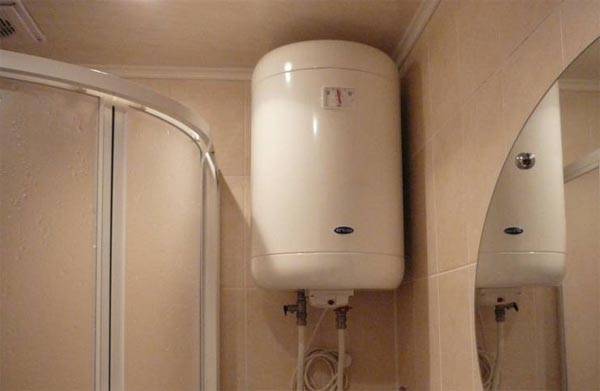
In turn, floor-standing water heaters are the safest and most reliable regarding this issue. You do not have to worry about the boiler falling off and falling, since they are supported by horizontal carriers.
If a large family has a shower, it is best to direct your gaze to storage water heaters, they have large tanks and are installed on the floor. All floor standing water heaters are partially attached to the wall.
Solid fuel equipment
The most primitive units for producing hot water are devices that use the energy released during the combustion of solid fuel (coal, firewood, etc.) as a power source. In this case, the consumer does not depend on the gasification of housing and the availability of electricity. Solid fuel devices are among the simplest and most economical types of equipment. If you wish, you can design them yourself.
Column-water heater on wood Opop LK 100
In addition to those listed, heaters can also be used for the operation of which other sources are used, for example, solar energy.
Cumulative
Apparatuses of this type represent a reservoir with a heating element, which allows providing the consumer (moreover, several points at the same time, from which water intake is carried out) with a sufficiently large volume of hot water. However, its initial heating takes time (as a rule, from a quarter of an hour). Subsequently, the water is constantly heated to the required value. The volume of the container can be from 5 to 300 liters. It is possible to select a suitable unit depending on the version. They can be hung on walls or installed on the floor, they are vertical and horizontal, have a flat or cylindrical shape.
Electrolux EWH 30 Formax - electric storage water heater with enamelled tank cover in rectangular design
When operating this type of equipment, it is necessary to take into account some of the nuances:
- space is required to place the tank;
- with long-term stagnation of water in the tank, such water cannot be used for cooking, and even more so for drinking, since bacteria may appear there (it is recommended to periodically heat the liquid to maximum temperature values, and also choose models that have a special coating that protects against bacterial growth);
- if the device is not used for a long time, the water has to be drained (especially if the owners leave for the winter).
The main classification of water heaters
Consumers whose houses are equipped with gas communications often install heaters (columns) that run on this energy source. They are popular because of their efficiency and economy: the unit itself is not so expensive and gas costs the population much cheaper than electricity.
Electric water heaters
In units belonging to this category, tubular electric heating elements (TENs) are installed, which heat the water. Its heating rate is determined by the power of this device. The installation of such models can be done by hand; you do not need to obtain any permits for this. But compared to gas counterparts, their operation is much more expensive for the consumer.
Electric instantaneous water heater
The two types of devices discussed above are among the most common. However, other types of heaters can be used.
Indirect water heaters
In houses where heating equipment is installed in the form of boilers operating on gas, solid fuel or electricity, there is no need to install additional devices that heat water. In this case, heaters (boilers) of indirect heating are used, which do not have an energy source, but receive heat from the heating system. Such units are usually characterized by high power.
